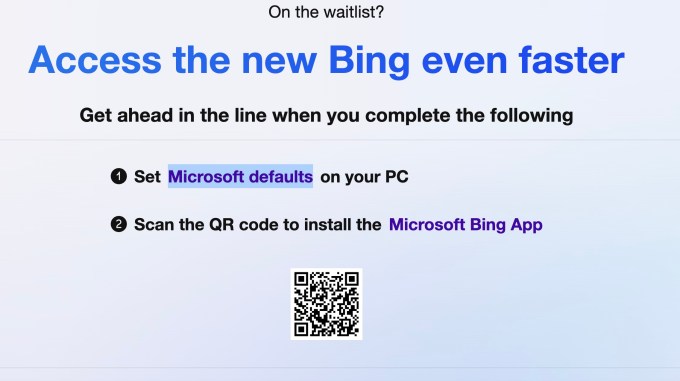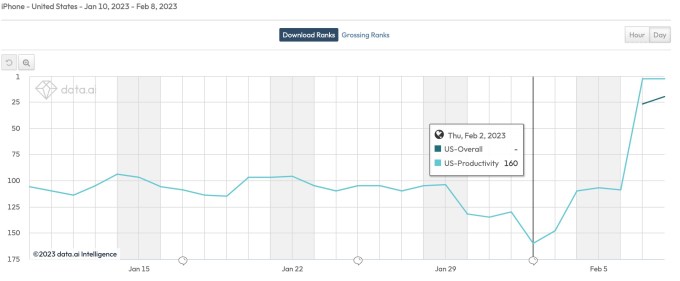This week’s news about Microsoft’s plan to add ChatGPT-like capabilities to its search engine Bing has sent its companion mobile app into the App Store’s Top Charts as of Wednesday. On the U.S. App Store, the Bing app has surged to the No. 12 spot among all free iPhone apps, while Microsoft’s Edge browser is now the No. 3 Utility app. Globally, the Bing app has seen a 10x increase in new downloads, according to preliminary estimates from app intelligence firm data.ai.
The movement indicates there’s sizable consumer demand for these new AI experiences, and users are even potentially willing to try new search engines and other browsers in order to gain access.
On Tuesday, Microsoft first showed off the new Bing.com which included the highly anticipated integration of a new, next-generation OpenAI large language model. The update adds a ChatGPT-like experience within the search engine itself, allowing users to converse with an AI chatbot for help with more complex queries and to aid in select content creation tasks — like writing a LinkedIn post. Microsoft also demonstrated a new version of its Edge web browser with the same AI features built into the sidebar for easy access.
But while the new version Bing has now technically launched, it’s still in a limited preview for the time being.
Users who want to try out the new AI features have to first join a waitlist. Microsoft said that “millions” of users will be invited from the waitlist over the next few weeks.
In the meantime, the company cleverly introduced a way to move up its waitlist. On a landing page, Microsoft suggests that users can gain quicker access to the new Bing if they complete a couple of additional steps. This includes setting Microsoft’s search as the default on their PC and scanning a QR code to install the Microsoft Bing App on their smartphone.

Image Credits: Bing waitlist website
The latter has clearly inspired the app’s rapid climb up the App Store’s charts — and it’s been a dramatic rise, at that.
Ahead of Microsoft’s AI news, Bing was not a popular app by any stretch. As of last week, for example, the app was ranked No. 160 on the U.S. App Store’s Productivity apps chart — in other words, practically invisible. It wasn’t ranked on the U.S. App Store’s Top Overall Charts at all. In less than a week’s time, it’s nearing the top 10 in the U.S. as is the No. 2 Productivity app, as of the time of writing.

Image Credits: data.ai chart of Bing’s app movement
If the consumer demand wasn’t there, Bing’s app wouldn’t have moved this significantly, despite Microsoft’s push to download it.
Of course, it’s worth pointing out that the App Store’s charts are susceptible to being manipulated by a rush of new downloads in a compressed period of time — which is why TikTok marketing that makes apps “go viral” has become so effective. Still, the Bing app’s movement is an interesting signal that demonstrates the demand for AI as well as the potential threat to Google.
Google is already paying Apple billions per year to be the default search engine in Safari. But if a large number of consumers move to another web search app like Bing or Edge in order to try out the new AI capabilities, Google could lose market share on one of the largest platforms consumers use to browse the web.
It’s possible, too, that some portion of the Bing app’s new users believe they’ll have access to the AI features from the mobile app. To be clear, that’s not yet the case as of yet. And though the app was recently updated, Microsoft makes no promises about using AI from this native iOS experience in Bing’s App Store description.
In addition to downloading Bing, as prompted by Microsoft’s website, some users may have downloaded Microsoft’s Edge browser on their iPhone, as well. While the Edge app hasn’t moved up the charts as quickly as Bing, it’s now No. 3 on the U.S. App Store’s Top Charts for Utilities, a slight bump from the No. 7 position it held Monday.
More specific figures around the total new installs may become available in the weeks ahead. If that’s the case, we’ll update with those numbers.
Bing’s app sees a 10x jump in downloads after Microsoft’s AI news by Sarah Perez originally published on TechCrunch






